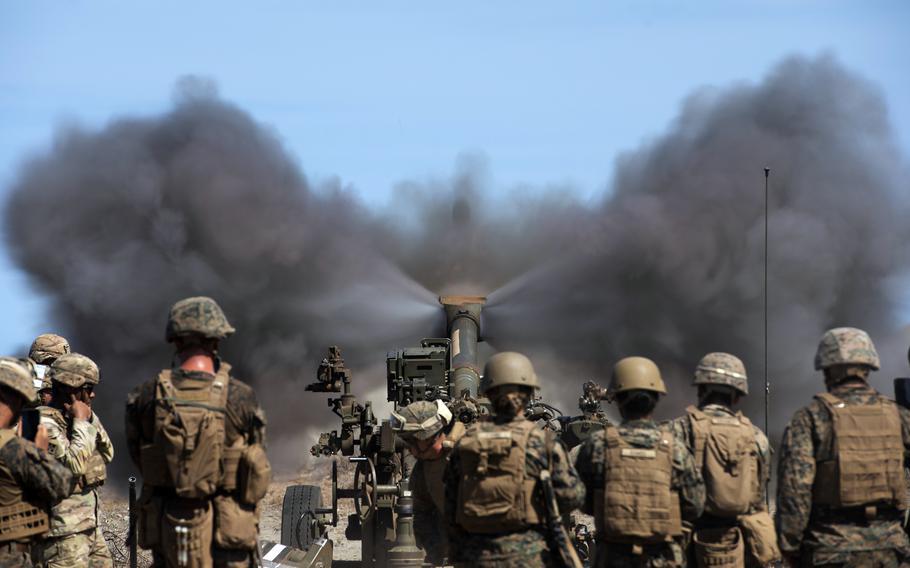
Members of the 3rd Marine Littoral Regiment fire an M-777 howitzer during a Balikatan drill at the La Paz Sand Dunes in Laoag, Philippines, May 6, 2024. (Jonathan Snyder/Stars and Stripes)
LA PAZ SAND DUNES, Philippines — American and Philippine troops blasted targets in the South China Sea on Monday, honing the skills they’d need to deter an invading force.
The training was part of the annual Balikatan exercise involving 16,000 mostly U.S. and Filipino troops that began April 22 and wraps up Friday.
This year’s Balikatan — “shoulder to shoulder” in Tagalog — is underway at a time of increased tension with Beijing, which has territorial disputes with the Philippines and several other nations in the South China Sea, along with designs on reunification with democratic Taiwan, by force if necessary.
The exercise’s U.S. task force commander, Marine Lt. Gen. Mike Cederholm, declined to say whether Monday’s coastal defense training, in sand dunes near the northern tip of the Philippines’ main island, was aimed at China.
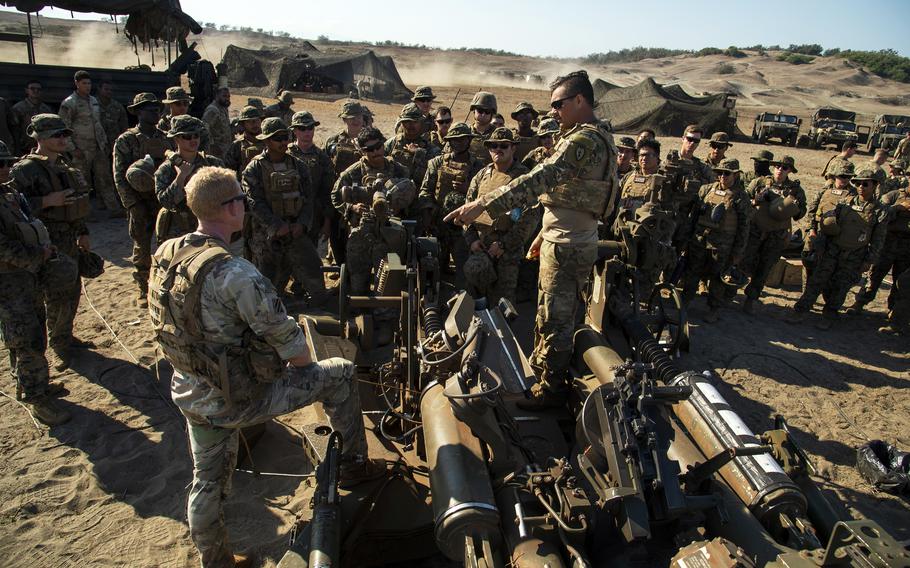
A soldier with the 7th Field Artillery Regiment speaks to Marines and sailors about the M-777 howitzer during a Balikatan drill at the La Paz Sand Dunes in Laoag, Philippines, May 6, 2024. (Jonathan Snyder/Stars and Stripes)
“We don’t do this (training) for any third party,” he told journalists gathered to observe the exercise. “But make no mistake, what you saw here today is to deter an amphibious landing.”
A pair of M-777 howitzers were placed in the dunes by soldiers from the Hawaii-based 3rd Battalion, 7th Field Artillery Regiment. The big guns took turns blasting 155 mm rounds at a fictional invasion force about four miles offshore.
As the notional enemy got closer, Filipino troops fired 105 mm artillery. Then members of the Hawaii-based 3rd Marine Littoral Regiment chimed in, shooting .50 caliber machine guns and Javelin anti-tank missiles at floating targets while a drone hovered overhead.
Balikatan is training troops to capture and defend key maritime terrain and allow them to strike enemy vessels from the land, Cederholm said.
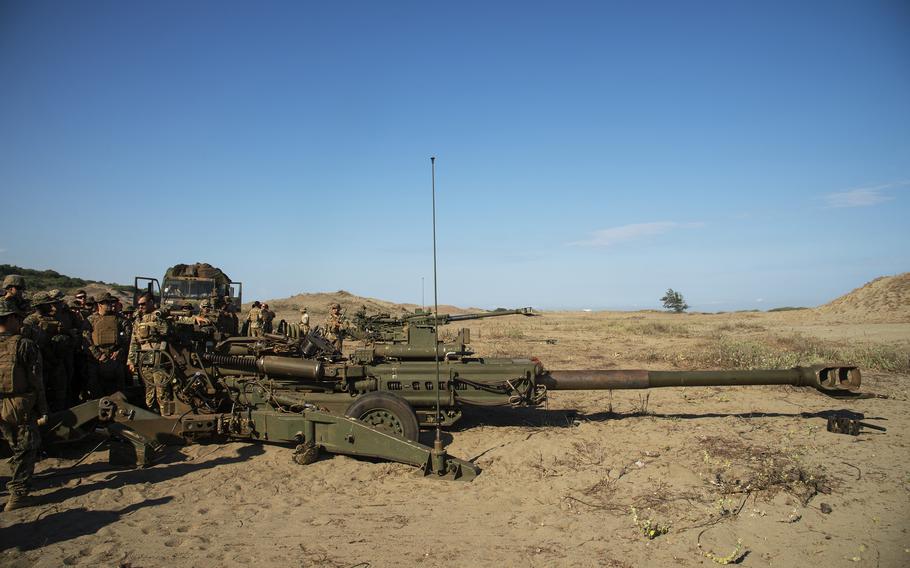
A soldier with the 7th Field Artillery Regiment speaks to Marines and sailors about the M-777 howitzer during a Balikatan drill at the La Paz Sand Dunes in Laoag, Philippines, May 6, 2024. (Jonathan Snyder/Stars and Stripes)
Asked if the training happened in the northern Philippines because of its proximity to Taiwan, Cederholm said the location has “no significance.” The site was chosen to enable U.S. and Philippine forces to work together and practice sea control and securing and defending key maritime terrain, he said.
Cederholm added, however, that the skills honed here are intended to help the Philippines defend its territory in the South China Sea.
Last week, a China coast guard ship with water cannons damaged one of two Philippine coast guard vessels at Scarborough Shoal, a feature inside the Philippines’ exclusive economic zone that’s controlled by Beijing. An escalating number of similar encounters have occurred between the two countries at Second Thomas Shoal, a submerged reef in the South China Sea controlled by Manila.
China has a sizable fleet of amphibious ships, retired Marine Col. Grant Newsham, a senior researcher with the Japan Forum for Strategic Studies in Tokyo, wrote in an email to Stars and Stripes on Monday.
“Ship-to-shore movement via landing craft, hovercrafts, and other lighterage is also something [China’s military] has basically long since figured out,” he said. “And as importantly, [China] regularly trains for amphibious landings.”
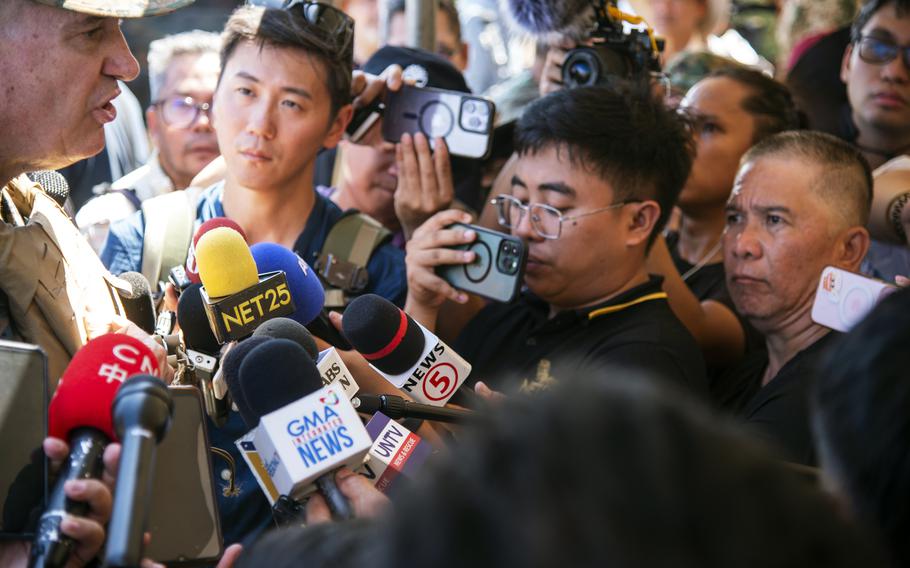
Marine Lt. Gen. Mike Cederholm, U.S. task force commander for the Balikatan, speaks to reporters about the exercise in Laoag, Philippines, May 6, 2024. (Jonathan Snyder/Stars and Stripes)
However, U.S. forces could sink a Chinese invasion fleet approaching the Philippines in short order, Newsham said.
“In terms of basic amphibious capability, the Chinese have the hardware and the know-how to go almost anywhere out to the first island chain and make a landing,” he said, referring to the islands that stretch from Japan through Okinawa, Taiwan and the northern Philippines. “Succeeding, if their opponent(s) fight back, is uncertain.”
Near the beach on Monday, Capt. Edward Fox, the fire-direction officer for 3rd Battalion, 7th Field Artillery Regiment, helped organize the barrage from beside a camouflaged Humvee.
“I’m used to training with land-based targets,” he said. “This is the first time I’ve done amphibious live fire.”
The artillery unit brought 44 soldiers to the dunes. They worked with 161 Marines, a few Navy corpsmen and some Filipino counterparts.
Fire direction for offshore targets is no different than shooting at targets on land, Fox added.
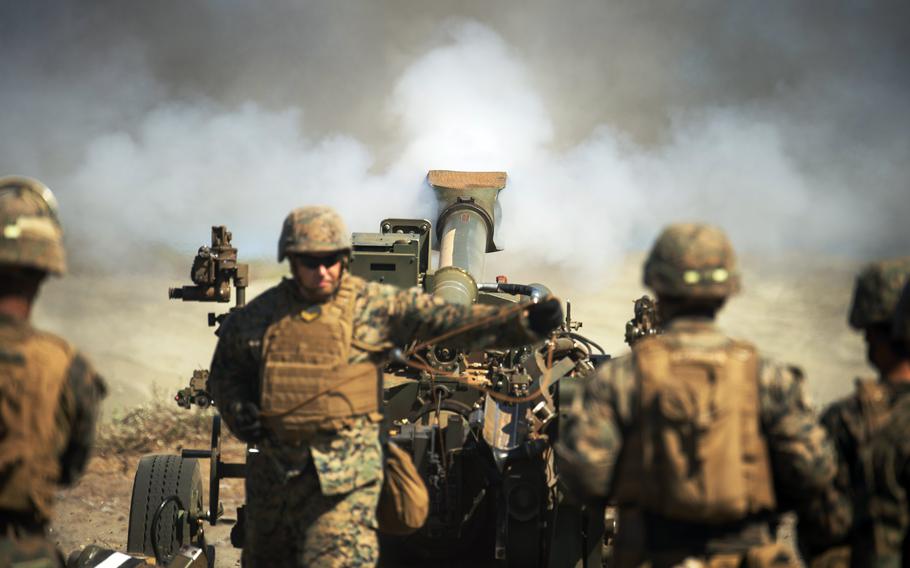
Marines and sailors with the 3rd Marine Littoral Regiment fire an M-777 howitzer during a Balikatan drill at the La Paz Sand Dunes in Laoag, Philippines, May 6, 2024. (Jonathan Snyder/Stars and Stripes)
“There’s nowhere for the enemy to hide during an amphibious raid, but there’s also not many places for forward observers to hide,” he said.
Navy corpsmen with the 3rd Marine Littoral Regiment and Marines from the Okinawa-based 7th Engineer Support Battalion, whose jobs don’t usually involve artillery, helped fire the howitzers.
“I had a smile on my face,” Navy Petty Officer 2nd Class Mathew Larmer said shortly after pulling a cord to blast a round from one of the big guns.
“The biggest thing I ever shot previously was a mortar,” said the hospital corpsman. “These [howitzers] are the kings of battle.”